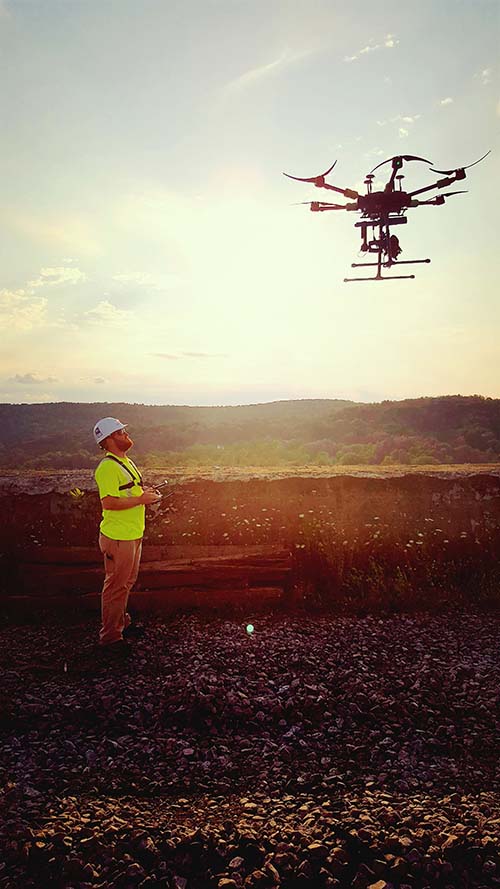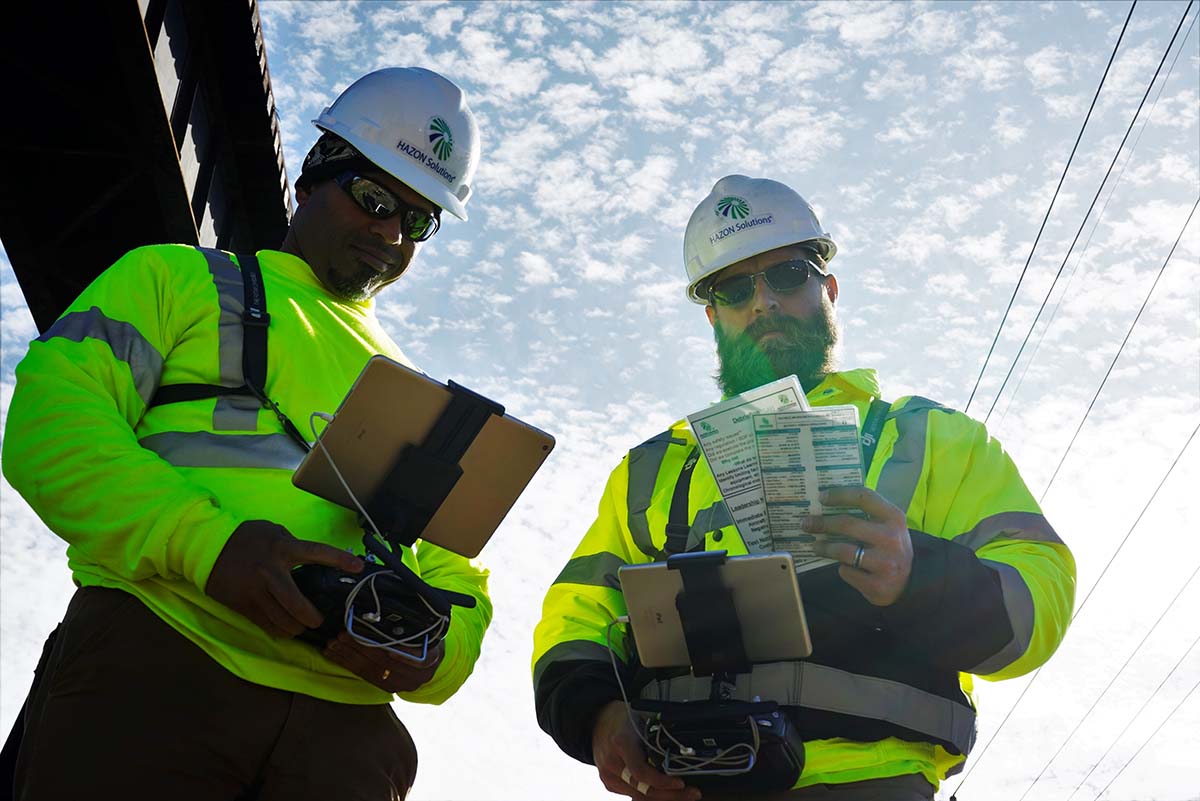One of the predictions for 2017 we made was around how companies would look to shift from “exploring” to “implementing” drone technology. Much of that was due to Part 107, as regulation had long been cited as the reason enterprise users were hesitant to adopt the technology. Under Part 107, regulation does not serve as a barrier to entry as it has in the past, and it’s gotten companies large and small to reconsider how they can and should be leveraging the technology.
One of the organizations that is working with professionals to effectively make this transition is HAZON Solutions. They’ve pioneered drone inspection service operations, capability development, training, drone safety and testing programs. Their mission is to conduct, support, develop, and validate small unmanned systems operations. To get a better sense of how HAZON has helped their clients make this transition and build drone programs that make sense for them, we connected with Ed Hine, Vice President - BD & Marketing at HAZON. He tells us about what makes the HAZON offerings distinct, what factors enterprise organizations should be thinking about as they consider adoption, what advice he would offer to anyone struggling with this transition and plenty more. Jeremiah Karpowicz: Can you talk about how you’ve seen this shift from “exploring” to “implementing” drone technology both approached and handled?Ed Hine: We find more and more enterprise level companies are making the move from investigation into adoption of unmanned aerial systems. Two classic options exist for enterprises looking employ drones in their daily operations. They can either insource the capability or outsource. Insourcing comes with the obvious manpower and training problems that many companies are not eager to take on. What are some of the factors that go into decisions around whether someone might choose to in-source or outsource?Outsourcing often presents a more comfortable starting point for an adoption phase. I believe most companies will end up in some type of hybrid scenario with a baseline capability insourced and more specialized work or higher volume work outsourced. We look to support companies in either case. In what ways are you able to support that kind of hybrid solution?We’ve built a consulting and training capacity that will help an enterprise stand up an organic drone operation. Our goal is to build a complete drone program that nests within existing enterprise policies and procedures to minimize the burden of adoption across a company. We offer consulting that builds out SOPs, maintenance programs, safety programs etc. We also offer training focused on live flight training and practical experience. What makes this kind of offering unique and something only HAZON can provide? At HAZON, we cut our teeth on comprehensive visual inspections of transmission lines and bridges. To date, we have delivered more than 8,000 transmission line structure inspections and over 100,000’ linear feet of bridges. That, combined with our leaderships naval aviation training background, led us to building our training and consulting program. We help organizations build the programs they need to be successful based on our naval aviation experience and our drone operations track record.What really makes us distinct is that we design programs to nest within an existing corporate architecture so that the SOP and maintenance program look feel and taste like the client’s own. A side benefit of this effort is that the added effort ensures employees will have an easier time adopting these new programs. We also conduct live flight training, both basic training and more advanced specialized training as well as in person Part 107 training classes.We have also act as a valued added reseller to training clients so they can avoid playing with multiple purchase orders. Those same training clients frequently ask us to conduct safety audits or recurrent training, which we happily do. Is there a certain type of stakeholder in an organization that you’ve worked with to create these kinds of programs? Or does it all depend on the type/size/business of a given organization? There doesn’t seem to be a single stakeholder type in any one organization. Many of our clients have chosen to nest their drone operation inside their corporate aviation department, which seems to be a good fit. The one common thread that we see is that the most successful companies are those that have and allow for strong internal champions of this technology. What are some of the factors that enterprise level organizations should be thinking about as they go through this transition, and especially as they consider their options when it comes to insourcing or outsourcing UAV adoption?If an organization is trying to balance insourcing vs outsourcing, then they are considering drone flying as a primary task instead of a “tool in the tool box”. It is also likely they are looking at fairly complex work. A good working assumption is that larger corporations will work less efficiently than smaller private UAS businesses such as HAZON.It should be assumed that any major organization standing up a drone program will collect and analyze less data per day but have the advantage of more direct control over an organic operation relative to a outsourced operations.At the end of the day there are a few key questions:
To get a better sense of how HAZON has helped their clients make this transition and build drone programs that make sense for them, we connected with Ed Hine, Vice President - BD & Marketing at HAZON. He tells us about what makes the HAZON offerings distinct, what factors enterprise organizations should be thinking about as they consider adoption, what advice he would offer to anyone struggling with this transition and plenty more. Jeremiah Karpowicz: Can you talk about how you’ve seen this shift from “exploring” to “implementing” drone technology both approached and handled?Ed Hine: We find more and more enterprise level companies are making the move from investigation into adoption of unmanned aerial systems. Two classic options exist for enterprises looking employ drones in their daily operations. They can either insource the capability or outsource. Insourcing comes with the obvious manpower and training problems that many companies are not eager to take on. What are some of the factors that go into decisions around whether someone might choose to in-source or outsource?Outsourcing often presents a more comfortable starting point for an adoption phase. I believe most companies will end up in some type of hybrid scenario with a baseline capability insourced and more specialized work or higher volume work outsourced. We look to support companies in either case. In what ways are you able to support that kind of hybrid solution?We’ve built a consulting and training capacity that will help an enterprise stand up an organic drone operation. Our goal is to build a complete drone program that nests within existing enterprise policies and procedures to minimize the burden of adoption across a company. We offer consulting that builds out SOPs, maintenance programs, safety programs etc. We also offer training focused on live flight training and practical experience. What makes this kind of offering unique and something only HAZON can provide? At HAZON, we cut our teeth on comprehensive visual inspections of transmission lines and bridges. To date, we have delivered more than 8,000 transmission line structure inspections and over 100,000’ linear feet of bridges. That, combined with our leaderships naval aviation training background, led us to building our training and consulting program. We help organizations build the programs they need to be successful based on our naval aviation experience and our drone operations track record.What really makes us distinct is that we design programs to nest within an existing corporate architecture so that the SOP and maintenance program look feel and taste like the client’s own. A side benefit of this effort is that the added effort ensures employees will have an easier time adopting these new programs. We also conduct live flight training, both basic training and more advanced specialized training as well as in person Part 107 training classes.We have also act as a valued added reseller to training clients so they can avoid playing with multiple purchase orders. Those same training clients frequently ask us to conduct safety audits or recurrent training, which we happily do. Is there a certain type of stakeholder in an organization that you’ve worked with to create these kinds of programs? Or does it all depend on the type/size/business of a given organization? There doesn’t seem to be a single stakeholder type in any one organization. Many of our clients have chosen to nest their drone operation inside their corporate aviation department, which seems to be a good fit. The one common thread that we see is that the most successful companies are those that have and allow for strong internal champions of this technology. What are some of the factors that enterprise level organizations should be thinking about as they go through this transition, and especially as they consider their options when it comes to insourcing or outsourcing UAV adoption?If an organization is trying to balance insourcing vs outsourcing, then they are considering drone flying as a primary task instead of a “tool in the tool box”. It is also likely they are looking at fairly complex work. A good working assumption is that larger corporations will work less efficiently than smaller private UAS businesses such as HAZON.It should be assumed that any major organization standing up a drone program will collect and analyze less data per day but have the advantage of more direct control over an organic operation relative to a outsourced operations.At the end of the day there are a few key questions:- Do you have enough work to necessitate a full time team? If so, how many full time teams?
- Do you already have a manned aviation department with a working knowledge of FAA regulations? If so, we highly recommend leveraging that department in this endeavor.
- Do you have the manpower resources to either create a team from scratch or re-organize to develop an internal team that will have drone flight operations as a primary task?
- Do you have contacts or support networks that can help you develop the programmatic support an unmanned operation needs (SOP, training, safety management system, etc)?
- How are you going to manage the administrative data that goes along with a flight operation (Training standards, qualification records, flight logs, maintenance records, etc)?
















Comments